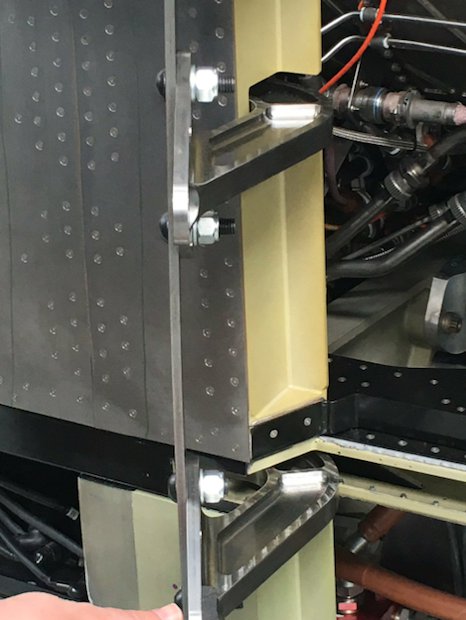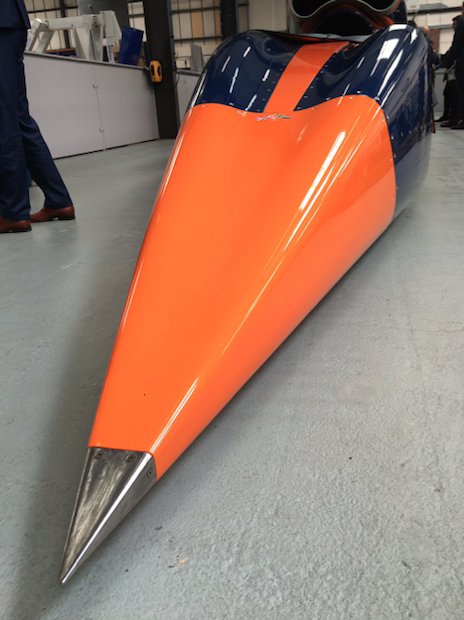So yesterday I discovered a few things. One: when I’m still an hour and half away from hitting the snooze button for the first time on an average weekday morning, the world is very much alive and kicking at 5.30am. Two: the prospect of snow must still be considered in your choice of coat even if May is just around the corner. And three: something that I consider to be a super cool, massive feat in engineering, to an engineer, is simply just “a blue and orange car”.
That car and the reason for my visit to Bristol yesterday is the Bloodhound, a military jet engine powered, potential Land Speed Record breaking, supersonic car weighing 7.5 tonnes and measuring approximately 13.4 metres long. Named after Bristol Aeroplane Company’s original surface-to-air missile that went out of service in the 90’s, the Bloodhound design is made up of 3,500 parts produced via a number of manufacturing techniques including subtractive, formative and additive manufacturing.

Despite the fancy 1000mph record breaking tagline, it’s those processes happening under the surface that were the real intrigue at yesterday’s gathering in the “most unpretentious building yet the coolest shed in the world”, as Delcam’s Chris Jones described the Bloodhound SSC Technical Centre. Just as the original Bristol Bloodhound talked about the benefit of lightweighting all the way back in the last century, a consortium of seven companies have come together for the LIGHT project to research how lattices and metal additive manufacturing can add value in terms of lightweighting in the manufacturing process, some of which has been applied to the car itself.
The Bloodhound is a product of ‘extreme engineering’ from Delcam, HiETA, CRDM/3DSystems, EOS, Simpleware and Magna Parva and funding from Innovate UK. It’s an open and collaborative venture where all research is shared and the car itself isn’t designed to be monetised. In fact Chief Engineer, Mark Chapman who has been on the project since 2008 said that education is “the reason this car exists” explaining that their main audience is actually 10-12 year old children who are excited by the idea of a car that can travel at such mind-boggling speeds.
I actually felt a little emotional when Mark played a video that showed a group of young school children taking part in their own speed challenge, inspired by a visit from the Bloodhound team. Maybe it was Elbow’s Lippy Kids’ ‘Build a rocket boys’ playing in the background or maybe it was the fact that it’s quite awe-inspiring to see young people excited by engineering and asking questions that us grown ups would never dream of asking either through fear of looking silly or just because we don’t have that inherent curiosity that makes kids wonder “how high does it go?” for a land-based vehicle.
Of course there is a lot of value in the project for engineers and the learning potential is massive due to the open nature and visibility. This was demonstrated in three case studies from individual arms of the LIGHT consortium including Magna Parva, HiETA and Bloodhound SSC who have been researching best practices for lattice structures and metal additive manufacturing for projects in space and back on land for the Bloodhound car itself. The results ranged from the successful to the not-so-successful but each offered their own value in terms of learning.
Get your FREE print subscription to TCT Magazine.
Exhibit at the UK's definitive and most influential 3D printing and additive manufacturing event, TCT 3Sixty.

The Bloodhound team are not setting out to reinvent the wheel with this car and they’re not about to use AM just because it’s a ‘megatrend’ for the coveted fourth industrial revolution. Mark told us how the suspension system design was a product of 30 minutes playing around with a desk, tubes and duct tape rather than several weeks developing appropriate software – but worked just as well. Likewise, the aluminium body of the car was produced by one guy ‘Gary’, who used a conventional English wheel tool to hand roll the sheet metal using traditional artisan skills. On the other hand, there are certain instances where AM was the ideal choice, particularly in the brake hinge bracket where topology optimisation was used to generate the best possible design which was then later produced via AM and finished with subtractive processes. Doing it this way provided a significant 10% weight saving on each bracket of which the car has eight. Other AM components include parts of the main body, the nose of the forward structure, the steering wheel and various inner tubes and structures.

The Bloodhound genuinely is a product of passion and collaboration from the additive steering wheel that was designed by a GrabCAD competition winner to the animation material that was created by neighbouring design studio, Aardman – of Wallace and Gromit fame. It’s an ongoing project and it's spread out much further than the walls of this high-tech shed on an Avonhead industrial park. In fact, in the Northern Cape Province in South Africa, where the car will eventually makes its record attempt, Bloodhound has completely transformed the community and is now the largest employer in the area.
The team plans to take the car for its first test in Newquay, UK next year before embarking on its journey to Hakskeenpan in the Kalahari Desert. There’s still a way to go and many unknowns to uncover in the process – there are no set rules after all - but that’s the point of this “blue and orange car” - to learn lessons, provide information, create a legacy and eventually, break a world record.










